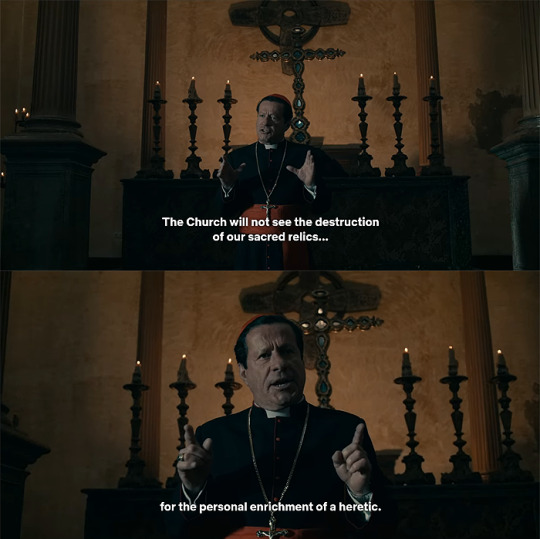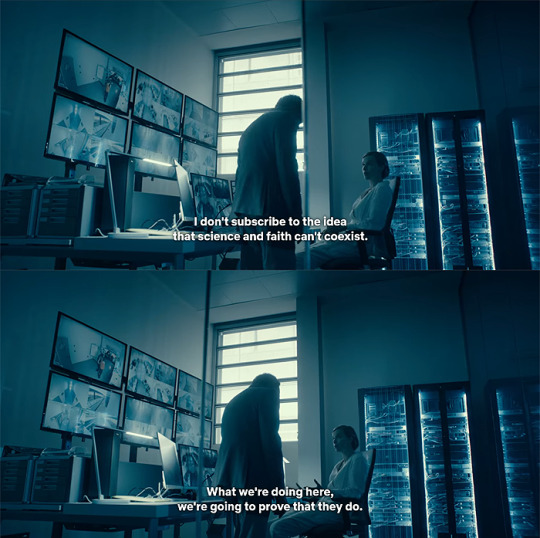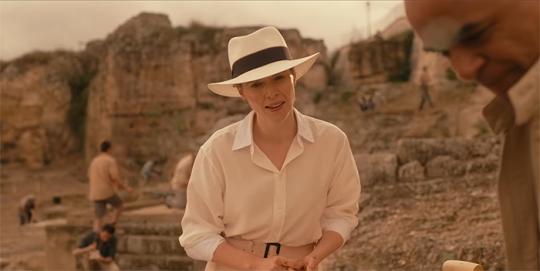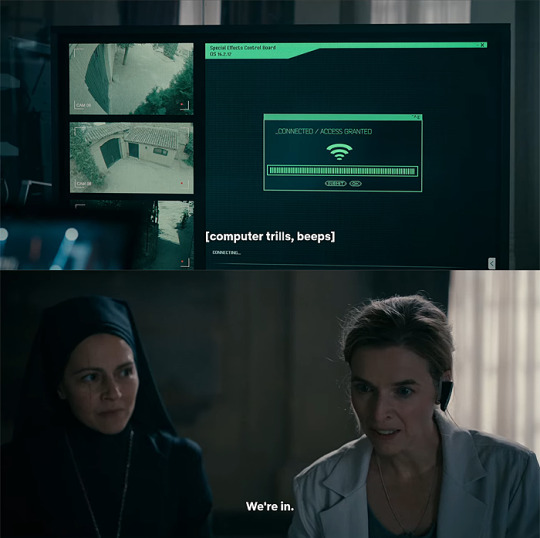#maaloula
Explore tagged Tumblr posts
Photo

Louay Kayali (Syrian, 1934-1978)
Maaloula
oil on canvas
© MutualArt
21 notes
·
View notes
Text
#syria#aramaic#ancient language#maaloula#syrian village#writing help#writing research#writing resources#oc ideas#roleplay ideas#save aramaic#my post
0 notes
Video
2010-04-13 In Maaloula by Petr Beránek Via Flickr: Syria - In Maaloula (My Friend´s Jarda V. Photo)
0 notes
Text
Warrior Nun truly is the most fucked up fucking show in the whole fucking world isn't it
Thecla (Ancient Greek: Θέκλα, Thékla; Greek: Θέκλα; Turkish: Tekla) was a saint of the early Christian Church, and a reported follower of Paul the Apostle. The earliest record of her life comes from the ancient apocryphal Acts of Paul and Thecla.

In one scene, female beasts, particularly lionesses, protected her against her male aggressors.



It is also said that Thecla spent the rest of her life in Maaloula, a village in Syria. There, she became a healer and performed many miracles...


...but remained constantly persecuted.


In one instance, as her persecutors were about to get to her, she called out to God, a new passage was opened in the cave she was in, and the stones closed behind her.


Around AD 280, Thecla features as one of the characters in Methodius of Olympus' Symposium, in which she displays considerable knowledge of profane philosophy, various branches of literature, and eloquent yet modest discourse. Methodius states that she received her instruction in divine and evangelical knowledge from Paul, and was eminent for her skill in sacred science ("Logos 8").




According to some scholars, Thecla's story inspired many later stories of women saints who dressed as men



All of these women were empowered by Thecla, a woman who did things that not many women would ever dare to do
In Spanish-speaking countries, she is also facetiously counted as the patron saint of computers and Internet, from the homophony with the Spanish and Catalan word tecla ("key").[citation needed]



(text on Thecla of Iconium taken from Wikipedia)


#jillian salvius#warrior nun#thekla reuten#I'M NOT SAYING THIS MEANS ANYTHING I'M JUST SAYING#[insert i'm not saying it's aliens but it's aliens meme here lol]#the craziest thing about it is that i wasn't looking for it. i was reading on tiepolo#as in yes art history. then a painting about a st thecla showed up in the text and it all snowballed from there#you have to admit that some of these parallels (or quasi-parallels anyway) between jillian and st thecla are... uncanny#funny and or misc#no i am not putting this in my analysis tags because this is for the lols (or is it)#editing this to add in the tags that sylvia de fanti is a leo#so a lioness in her own right so to speak. when lionesses were the ones to protect st thecla#i mean if you really want to fuck it up... thekla is a virgo. jillian as a VIRGIN MARY figure anyone...?#if we're gonna mix up real life and fiction might as well do it in style huh#this fucking show sdkljfghsdkjghkjsg#OKAY FINE I AM PUTTING IT IN MY PERSONAL ANALYSIS TAG#exercises in observation
109 notes
·
View notes
Text
ok here's another explainer post explaining the aramaic language very basically:
what is aramaic?
to paraphrase wikipedia, aramaic is a northwest semitic language that the arameans (where the name comes from) spread somehow a really long time ago. it since became the prestige language in a bunch of empires like the neo-assyrian empire. although its place was eventually taken by other languges, it's still preserved to this day in many different forms.
nowadays, "aramaic" is a broad label for a very diverse dialect continuum, sort of like “arabic”, “kurdish”, “persian”, or “hindustani". in other words, it's like if we referred to all the languages in italy, including older ones like the latin spoken in roman times, collectively as “latin”. (this isn’t too far off how some governments think of minority languages actually, but that’s beside the point.)
how is aramaic related to other semitic languages?
being a northwest semitic language, aramaic is a sister of the caananite languages (making it an aunt of hebrew and phonecian), a cousin of arabic, and the second cousin of the ethio-semitic languages (making it the second cousin once removed of ge'ez). if you need a comparison, english is the second cousin of dutch.
how is aramaic used today?
specific sorts of aramaic are used today for religious and vernacular purposes. some religious aramaic:
classical syriac, which developed from eastern aramaic, is the liturgical language of the christian east and west syriac rites, each using their own dialect. classical syriac was also historically used as a literary language.
mandaic has a similar history, and is now used in the liturgy of the mandaean faith of the ethnoreligious mandaean people.
targumic aramaic refers to the archaic aramaic used in several antique translations of the tanakh from biblical hebrew into aramaic. the talmud is also in two different versions of older aramaic as well as mishnaic hebrew. these are used for study in general by all jews, and yemenite jews still use the targumim liturgically.
samaritans also have their own aramaic which is similar in form and use the jewish one.
all of these forms of aramaic are different evolutions in their own right - influencing and possibly descending directly from newer aramaic forms. we don’t know exactly what came from where, and linguists tend not to always be exactly right when figuring it out (which is why “vulgar latin” was a thing people thought was real for a while).
the vernacular aramaic spoken today are the neo-aramaic languages, which represent the latest vernacular evolutions of aramaic from late medieval times. most of the neo-aramaic varieties spoken today are central and northeastern neo-aramaic, which stem from eastern aramaic, and most of the speakers are ethnic assyrians. smaller communities speaking the only surviving variety of neo-aramaic which came from western aramaic exist in a few villages along the anti-lebanon mountains (like the village of maaloula in syria). a mostly aging community of judeo-aramaic speakers live in palestine.
a map of the homes of the living neo-aramaic varieties, which doesn't necessarily reflect where each variety is spoken (the labels are a bit confusing - pretend syriac/aramaic say "neo-aramaic", and specifically that "western syriac" says "central neo-aramaic"):

here's a map of the "larger" judeo-aramaic varieties by 1948 (judeo-aramaic was generally spoken in these areas but "smaller" dialects may not be shown or named):

i should say that not all speakers of these types of aramaic agree with some of the names linguists have ascribed what they speak. for example, "turoyo" speakers refer to their language as "surayt". linguists also gave the name "aromay" to the neo-aramaic spoken in maaloula, but the speakers themselves refer to their language as "siryon". "neo-aramaic" is itself an exonym. this part of the world is in general not written about a whole lot, and when it is, it's not always with the input of the people who are from there.
another interesting thing about the names is that, while christians tend to call it some form of s-y-r (sureth, suryat, siryon, etc, ie syriac), jews tended to call it some variation of either "our language", "jewish", or "targumic". you can find this in some other jewish languages/dialects/ethnolects.
christian/assyrian varieties seem to be a lot more widespread than jewish ones. what's that about?
there's a lot more christians in the world than there are jews.
what do you mean by “jewish” neo-aramaic, anyways?
"jewish neo-aramaic" is a term linguists gave to the many languages jews in those regions on the map spoke which are descendants of araaic. like the other types of neo-aramaic, judeo-aramaic is not one, all-encompassing language, but multiple languages that all happen to be spoken by jews. variations in regional languages can be as small as from town to town all over the world, communities with some form of separation may have their own dialects, religion has often had an effect on where you lived in the me historically, and this part of the world was known to be a place you fled to if you didn't like whatever government was in power (you could call it the "mashriq's appalacia"), hence, jewish neo-aramaic[s].
the degree of mutual intelligibility between jewish neo-aramaic types and other neo-aramaic types varies - some are unintelligible to other kinds despite the two being in the same city/town, others are exactly the same save for the stress in a word being on different syllables. differences don't mean jews and other aramaic-speakers couldn't have spoken each other's dialects, understood each other, or gotten influence from one another in addition to other contact languages. there was usually some other sort of medium they were using, be it arabic, kurdish, turkish, or a "neutral" aramaic. it's kind of like an amplified version of the differences between different arabic dialects in that way.
the association of "jewish language" usually brings about the questions of loanwords from hebrew or targumic (which many jewish neo-aramaics did have), mutual intelligibility with the "standard" form of a language, or social isolation (such as in yiddish, which itself wasn't even isolated, quite the contrary in fact), but that isn't what makes a jewish variation of a language "jewish". it's more that some variation of a language was used by jews in a specific context. (sort of like how the class differences in different english accents in the uk don't actually render different types of british english unintelligible to one another. or even how i'd probably avoid talking to my mom about my favorite video game characters because she has no idea what a "jun oda" is, but i can talk to her about other things.)
what about muslims? did/do they speak aramaic?
you can't switch the language you speak overnight, so yes, muslims who lived in places where aramaic was still widely spoken spoke aramaic instead of and even in addition to other languages in the past. also, that someone stopped speaking aramaic doesn't necessarily mean it's gone forever - not only are muslims thought to have retained an understanding of aramaic their non-muslim neighbors may've spoken even if they didn't speak it themselves, but aramaic influenced some of today's regional arabic dialects. (more on that later.) the association of neo-aramaic with non-muslims is actually rather recent in that regard.
as for aramaic-speaking muslims today, most of the the aramaic-speakers in the speaking communities on the anti-lebanon mountains i talked about earlier are muslim. the communities are close-knit, and the isolation helps.
and what about mandaeans and samaritans? do they have a vernacular aramaic?
not only do mandaeans have one - neo-mandaic - but it's the only surviving pre-medieval vernacular aramaic dialect. (it’s the only vernacular aramaic that isn’t a “neo”.)
i’m sure samaritans also had their own vernacular aramaic before switching to arabic (which they spoke before the occupation happened). western vernacular aramaic usually didn’t last.
how come? does it have anything to do with most neo-aramaic being central and northeastern, like the map showed?
it does. differences in geography (east med = more densely populated; north mesopotamia = less densely populated and more mountains), which pre-arab and post-jesus empires ruled where (byzantines ended up with most of the places west aramaic was spoken), and how much those empires cared about aramaic resulted in arabic taking over as the vernacular in pretty much all the western areas except in more rural places, while more of the generally more isolated eastern aramaic-speaking communities lasted. in general, the more urban and shami you were, the shorter time it took you to adopt arabic.
also, classical syriac having a lasting literary history and barely any western aramaic languages being able to say the same contributed to what future generations were able to pick up on. the greek-influenced christians in those west armaic speaking areas had a habit of burning aramaic-language manuscripts because of church fandom drama. there's some revival efforts in traditionally western neo-aramaic speaking communities, though in places like palestine and lebanon, these may take on a certain political dimension that they don't have elsewhere.
what else differentiates different types of aramaic?
the same things that differentiate different versions of other dialect continuums: languages speakers spoke before, the passage of time, different neighboring languages, and geographic distance (“western”, “eastern”) bring about new quirks in pronunciation/phrasing/grammar/loanwords. this is pretty heavy stuff, so if you want the specifics, i recommend looking into the timeline of a specific aramaic language.
is western neo-aramaic closer to what jesus spoke? is it more authentic?
in theory, sure - he would've spoken a western vernacular variety called galilean jewish aramaic specifically. in reality, this question is like asking if british english is more authentic to the english shakespeare spoke. aramaic in general and the world as a whole have changed so much from the time jesus would've lived. he would understand any of today's aramaic just as much as shakespeare would understand the english spoken on tiktok.
how's mutual intelligibility?
it can vary significantly or not at all, but the same aramaic "basis" is still there in all forms. i'd wager it's about the same level of differences you'd find between different romance languages.
here's some transliterations of the lord's prayer (our father who art in heaven etc) in western neo-aramaic, suryat/turoyo, the eastern dialect of classical syriac, and (for some reason) hebrew courtesy of wikipedia to show a few differences:

or this one, of the assyrian and jewish urmia dialects:

did aramaic influence other languages at all?
like i implied in the second question, all the semitic languages are super close, and a lot of them have cognates or similar words/phrases. in that sense, it may not be as easy to say what definitively came from where, but that doesn't mean it's impossible.
before levantine and mesopotamian arabic speakers spoke arabic, aramaic was the lingua franca in the areas where they lived. aramaic forms a substrate in all of these types of arabic in loanwords, some pronunciation, and a few grammatical features. aramaic influence is more significant in certain types, such as in more rural dialects of levantine arabic as well as northern and jewish dialects of mesopotamian arabic, which speaks to how arabic spread in those areas. (i also heard the dialect of arabic marsh arabs speak has a lot of aramaic influence but i couldn't find a good source.) this is a pattern you can find in regional variations of arabic in general, such as the influence of coptic on egyptian arabic.
(arabic in general also has a number of aramaic loanwords, like دفتر (daftar), or "notebook". this word is originally greek but came via aramaic.)
hebrew, being often used together with it in the past (and aramaic eventually supplanting it as a spoken language), has been influenced by it for a while now. aramaic also formed an influence on pretty much all the non-aramaic (since those are already aramaic) jewish languages in a similar way to what happened with levantine/mesopotamian arabic, though hebrew influences jewish languages more than aramaic generally. it also influenced most of the loans in modern hebrew, including the words they made up (like "glida" for "ice cream", which comes from an identical word meaning "ice" or "frost". i don't know if the word "gelato" had anything to do with this as well, but it might as well have.)
aramaic also has influences on kurdish, farsi, armenian, ge'ez, turkish, latin, greek, and probably more that i can't think about right now via loanwords and terms, though they're not as significant. and yes, that latin/greek means we have aramaic-derived words in english, too, such as "messiah", though they're mostly in the form of given names like "matthew" and "peter".
is aramaic endangered? are the other varieties of aramaic extinct?
the religious languages are all in continuous use in one way or another, but not as vernacular with native speakers, so they'd be considered "dead". (this is what hebrew was before its revival.) an "extinct" language is a language that didn't even survive via written records, which some varieties of aramaic (mostly western ones, like i mentioned earlier) are.
as for vernacular aramaic, all of them are endangered - i don't think there's any varieties with over a million speakers, and no varieties are an official language anywhere - but some varieties are safer than others. the ones that are doing the worst right now are probably neo-mandaic (which only has a few thousand native speakers), the jewish neo-aramaic dialects (which can vary from a few thousand to a few hundred to single digit speakers, the one with the most speakers right now is the hulaulá ("jewish") dialect with 10,000 due to most of its speakers coming much later than others (from iran in 1979)), and a handful of christian/assyrian regional dialects (like the one of hertevin).
western neo-aramaic is endangered in the sense that it's the only surviving vernacular western neo-aramaic with a speaking community, but there's 30k speakers as of 2023, so it could be doing worse.
what scripts are used to write aramaic?
it's worth noting that vernacular neo-aramaic everywhere was only passed down orally for generations, and written forms, especially for teaching, are quite recent. also, all the scripts i'm about to mention are right-to-left abjads. that said:
the old aramaic script was used to write it in the past. from a combination of it and paleo-hebrew developed the hebrew script (which used to be called "ktav ashuri", or "assyrian script"), which has been used to write all jewish variations of aramaic since, and is used to write judeo-aramaic today. samaritans use their own script to write in aramaic.
the old aramaic script also birthed the nabataean script (which is the parent of the arabic script) and a few historic persian scripts like the pahlavi script (which gave us the avestan script).
syriac script, in use from the first century, is used to write classical syriac as well as the many varieties of neo-aramaic spoken by christians/assyrians today. the revival efforts in maaloula originally used a very familiar script but eventually switched to the syriac one because that one looked a little too familiar.
the syriac script also developed from the aramaic script. (if you know how to read the hebrew or arabic scripts, see if you can recognize letters below.) there's some variations between the eastern and western syriac scripts (called "maḏnḥāyā" (eastern) and "serṭā" (line) respectively), along with the classical 'esṭrangelā (rounded) script. the two main differences are:
vowel notation - western uses small greek letters (ܓܱ = ga, notice the small A on the bottom), eastern uses an older form (ܓܲ = ga, with a dot above and below). like with other abjads, you won't usually see vowel notations in use at all.
font/shape - you can't see them in unicode, but each have a particular style they're written in. as you can guess from the name, 'estrangela is more "rounded", eastern is generally heavier and conservative in its rendering, and western is more simplified. (the kind used in unicode is 'estrangela.)
some examples, again courtesy of wikipedia:

syriac script also has some descendants. its child, the sogdian script, was used to write the iranian sogdian language, and is the parent of the manichaean aramaic script, the old turkic script (which gave birth to the old hungarian script), and the old uyghur script (which gave birth to the mongolian and manchu scripts).
mandaic also has its own script, the mandaic script. it's another descendant of the aramaic script (maybe via parthian) in use since the 2nd century ce. it's used to write both classical and neo-mandaic. instead of traditional semitic letter names like "aleph", "bet", "gimel", etc, it's known to use its own names, like "a", "ba", "ga", etc. neo-mandaic uses a modified version of the classical script but it's barely written to begin with.
here's a written sample of article 1 of the universal declaration of human rights written in classical mandaic script:

i don't have any familial or religious connection to aramaic, but i'd like to learn it. can i?
after you pick which sort of "aramaic" you wanna learn, i don't see why not. it's not closed or anything. there's probably someone out there who feels differently but that's their problem.
where can i learn [aramaic type], or learn more about it?
i'm trying to find this out myself. the only actual judeo-aramaic learning resource i could find was the mysterious once-a-year class offered by oxford's school of rare jewish languages. that said, here's some resources i know about:
northeast neo-aramaic database project - a database by cambridge of info on different dialects of nena neo-aramaic, including recordings, layouts of the grammar, and comparisons between different dialects.
resources on reddit's language learning sub
two pdfs to make up for that broken first one
šlama.io - focuses on assyrian neo-aramaic (sureth)
surayt.com - resources for surayt
mandaean network - resources on mandaic.
r12a - resources on how different scripts in all languages work, good resource for languages/scripts in general.
if you know any more resources, reply with them to this post and i'll put 'em here.
18 notes
·
View notes
Text
happy belated feast of the Assumption!! my great grandfather was from the Syrian town Maaloula, which is painted blue in honor of the Virgin Mary on the 15th of August. Hopefully I will get to visit someday!
0 notes
Video
youtube
Syrie : Maaloula, le village où l'on parle encore l'araméen, la langue de Yahshua / Jésus - vu du ciel - 2019 (Syria : Maaloula, the village where Aramaic, the language of Yahshua / Jesus, is still spoken - seen from heaven - 2019)
Maaloula est situé à 55 km au nord de Damas / Maaloula is located 55 km north of Damascus
Légende de la vidéo “ Maaloula, Syrie, septembre 2019. L’histoire de ce petit village, on a dû vous la raconter plusieurs fois. En 2013, une armée de jihadistes a envahi entièrement le village, tuant des hommes, des femmes et des enfants. Aujourd’hui, l’avenir se tourne vers la reconstruction. J’ai souhaité me rendre une seconde fois dans ce village afin de filmer la fête de la croix.
Maaloula est à l’image de tout ce pays, un coin du monde que certains ont voulu détruire mais qui, aujourd’hui, est plus vivant que jamais… “

Video caption “ Maaloula, Syria, September 2019. The story of this small village must have been told to you several times. In 2013, an army of jihadists invaded the entire village, killing several men, women and children. Today, the future turns to reconstruction. I wanted to go a second time to this village to film the feast of the cross.
Maaloula is the image of this whole country, a part of the world that some people wanted to destroy but which, today, is more alive than ever… “
youtube
The Aramaic Lord’s Prayer / La Prière “Notre Père” en araméen par Ashana
Pureté de la voix / Purity of voice
♥ ♥ ♥
Translittération
Aboon Dbishmeya (Notre Père qui es aux cieux)
Nethcadash shmarh (Que soit sanctifié votre nom) Teethe malkioothokh (Vienne votre règne) x2 Nehwe sebyonokh (Soit faite votre volonté) Eikén en dbishmaya aff’hara (Aux cieux comme sur terre)
Aboon Dbishmeya (Notre Père qui es aux cieux)
Hab lan larhman sourane en yawmano (Donnez-nous notre pain quotidien aujourd’hui) Wesh boorlan houbènnou (Pardonnez-nous nos offenses) x2 Eikén doff nann shouaria lohra yo houbèn (Comme nous, nous pardonnons nos offenseurs)
Aboon Dbishmeya (Notre Père qui es aux cieux)
Ouella tal’ann in tçiona (Ne nous soumettez pas à la tentation) Ella-pass’ inn min bicha (Délivrez nous du mal) x2 Motorrl-dilair té malkiootho (Car vous appartient le règne) Ourhayloo tooshpoorhta lalaïla Amin (La puissance et la gloire, Amen)
Aboon Dbishmeya (Notre Père qui es aux cieux)
0 notes
Text
0 notes
Text

02 Paintings, Middle East Artists, Louay Kayyali's Maaloula, with Footnotes, #65
Please follow link for full post
Middle East,Art,Zaidan,Paintings,Calligraphy,fine art,Maaloula,biography,History,Louay Kayyali,Artists,footnotes,
MiddleEast #Zaidan #Artists #biography #Art #Paintings #Artists #History #footnotes #Calligraphy #fine #art
0 notes
Photo

Syria by bilwander Via Flickr: Palmyra, the Roman amphitheatre Syria slideshow / 177pics
#Syria#Damascus#Aleppo#Palmyra#Yarhai#Fakhr#al#Din#Maani#Bosra#Hama#Hims#Homs#Idlib#water#wheel#norias#Afamia#Apameia#Maaloula#Saydnaya#Krak#des#Chevaliers#Omayad#mosque#Valley#tombs#Tower#Tomb
26 notes
·
View notes
Text

Saint Takla Monastery, Maaloula, Syria.
دير مار تقلا، معلولا، سوريا.
14 notes
·
View notes
Text
Apr 2014
President Bashar al Assad visited historic Christian town Maaloula where Aramaic, the language of Jesus Christ, has survived for centuries and is still spoken.
US-sponsored jihadists destroyed the ancient Church and the statue of Virgin Mary.
#war on Christianity#syria#syrie#siria#سوريا#سورية#middle east#syrian president#bashar al-assad#assad#الأسد#Easter#Maaloula#معلولا#virgin mary#Jesus#jesuschrist#Europe#europa#EU#trump#al qaeda#war on syria#syrian culture#syrian civilization#culture#Syrian arab army#عيد الفصح#فصح مجيد#Catholic
261 notes
·
View notes
Photo

Is this monastery still standing? Mar Takla #church, #Maaloula, #Syria #picoftheday (at معلولا) https://www.instagram.com/p/B_IY9YGgQV1/?igshid=2f205mk4p5nh
1 note
·
View note
Link
31 notes
·
View notes
Photo

In Syria’s old Christian town of Maaloula, Syrian children celebrate their First Communions. A beautiful sight that wouldn’t be possible if the Syrian Army and its allies didn’t free the city from terrorism.
#Syria#Maaloula#Syrians#Christians#Christianity#Middle East#Arab World#Beautiful#Inspiring#Faith#sahouraxo#Sarah Abdallah#sarahabdallah
169 notes
·
View notes
